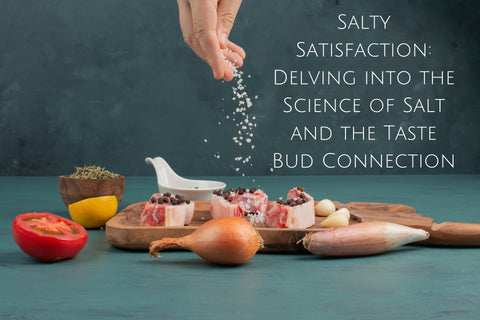Introduction:
Welcome to Salty Satisfaction, where we embark on a flavorful journey to unravel the mysteries of salt and its profound impact on our taste buds. In this blog, we'll delve into the fascinating science behind salt, its role in culinary traditions, and the intricate connection between our taste buds and the savory sensation of saltiness. Get ready to dive deep into the world of salty satisfaction!
Salt: A Culinary Essential:

Salt, the seemingly simple crystal, is a culinary cornerstone. It's more than just a seasoning; it's a flavor enhancer, a preservative, and a key player in many chemical reactions that occur during cooking. Let's delve deeper into the world of salt and explore why it's an essential ingredient in every kitchen.
The Science Behind the Flavor:

- Sodium's Role: Table salt, the most common type, is sodium chloride (NaCl). Sodium ions interact with taste receptors on our tongue, triggering the perception of saltiness. This basic taste sensation is the foundation upon which other flavors are built.
- The Art of Enhancement: Salt enhances the natural flavors of other ingredients. It draws out the savory notes in meats and vegetables, balances sweetness in desserts, and tames bitterness in some foods.
Beyond Flavor: The Functional Benefits of Salt

- A Natural Preservative: Salt inhibits bacterial growth, which historically made it essential for food preservation before refrigeration. While not the sole method today, it still plays a role in curing meats and extending the shelf life of certain foods.
- Texture Tweaker: Salt can affect the texture of food. In baking, it strengthens gluten strands in bread, leading to a chewier texture. In brines, salt helps tenderize meat.
Different Salts for Different Uses

The world of salt extends beyond the familiar table salt. Here are some popular varieties:
Table Salt:

Finely ground and often iodized (contains iodine), it's a convenient option for everyday use.
Kosher Salt:

Flaky crystals dissolve quickly, making it ideal for seasoning meats and brining.
Sea Salt:

Produced from evaporated seawater, it comes in various textures and has a slightly briny flavor. Good for finishing dishes.
Himalayan Pink Salt:

Rich in minerals and known for its beautiful pink hue, it's often used as a finishing salt.
Balancing Act:
Salt, our culinary companion, plays a balancing act on our plates. It elevates flavors, preserves food, and adds a satisfying touch to our meals. Here's a closer look at the importance of finding the right balance between enjoying the taste of salt and maintaining good health.
The Benefits of Salt:

- Flavor Champion: As discussed earlier, salt is a flavor enhancer. It unlocks the savory notes in ingredients and creates a well-rounded taste profile.
- Food Preservation: Historically, salt played a crucial role in preserving food before refrigeration. It's still used in curing meats and extending the shelf life of certain foods.
- Culinary Workhorse: Salt can influence textures. It strengthens gluten in bread dough, tenderizes meat in brines, and adds a satisfying crunch to pretzels.
Health Considerations:

The Positive Impact of Salt:
- Essential Nutrient: Sodium, a component of salt (sodium chloride), is an essential nutrient for our bodies. It plays a crucial role in nerve and muscle function, maintaining blood pressure, and fluid balance.
- Food Preservation: Historically, salt played a vital role in preserving food before refrigeration. While its use for preservation has diminished, it's still used in curing meats and extending the shelf life of certain foods.
- Flavor Enhancer: This is where salt truly shines. It elevates the natural flavors of ingredients, balances sweetness in desserts, and rounds out the taste profile of savory dishes.
Culinary Creativity:
Salt's reputation as a flavor enhancer precedes it. But for adventurous cooks, salt offers a surprising depth of culinary creativity. Let's delve into the unexpected ways salt can transform your dishes and elevate your cooking to new heights.
Unlocking the Spectrum of Flavor:
- The Science of Sweetness: Believe it or not, salt can enhance sweetness. A pinch of salt in cakes, cookies, or even chocolate chip cookies can temper the sweetness and make the flavors pop.
- The Magic of Umami: Salt plays a vital role in drawing out the savory, brothy taste known as umami. Experiment with using salt to amplify the deliciousness of broths, stews, and dishes rich in glutamic acid (a building block of umami) like mushrooms and tomatoes.
- Fat's Best Friend: A touch of salt can heighten the perception of fat. This is particularly useful in low-fat cooking where dishes can sometimes taste bland. A pinch of salt can make lean cuts of meat or lighter sauces taste richer and more satisfying.
Texture Tweaking:
- The Art of Brining: Soaking meats and poultry in a brine (saltwater solution) tenderizes the proteins, resulting in juicier and more flavorful results. This technique is a game-changer for grilled chicken, roasted turkey, or perfectly cooked fish.
- The Perfect Crust: Salt helps draw moisture to the surface of food, promoting browning and crisping. This is why a good sprinkle of salt is essential for achieving that golden-brown crust on roasted vegetables, perfectly seared steaks, or crispy French fries.
- The Science of Baking: Salt strengthens gluten in bread dough, leading to a chewier texture. It also helps control yeast activity, resulting in a more even rise. So, don't skip the salt in your baking recipes.
Conclusion:
As we conclude our exploration of salty satisfaction, we hope you've gained a newfound appreciation for the science of salt and its intricate connection to our taste buds.
Whether you're savoring a perfectly seasoned dish or contemplating the complexities of flavor balance, may your culinary adventures be infused with the savory satisfaction of salt. Here's to indulging in the salty delights that make every meal a culinary delight!




Comments (0)
There are no comments for this article. Be the first one to leave a message!